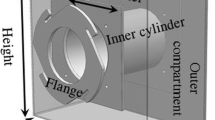Summary
The influence of local temperature changes within the posterior portion of the body on dorsal aorta blood flow (\(\dot Q_{da} \)), femoral arterial pressure (P a ), peripheral resistance (R), skin blood flow (\(\dot Q_s \)) and skeletal muscle blood flow (\(\dot Q_m \)) was examined in unanesthetized lizards (Iguana iguana andTubinambis nigropunctatus). In response to local heating of the hind legs and tail\(\dot Q_{da} \) and\(\dot Q_s \) increased,P a was generally unchanged,R decreased and\(\dot Q_m \) decreased or was unchanged (Fig. 2). It is suggested that the acquisition of heat may be favored by diverting the increase in\(\dot Q_{da} \) away from the muscle to the warmer skin. In response to cooling\(\dot Q_{da} \) and\(\dot Q_s \) decreased,P a was generally unchanged, R increased and\(\dot Q_m \) increased or was unchanged. Hence, during cooling the retention of heat may be favored by diverting blood away from the skin to the deeper muscle. The muscle-skin shunt is under sympathetic control since following blockade with phenoxybenzamine HCL (Dibenzyline) muscle blood flow changes in response to temperature were qualitatively similar to those of skin (Fig. 4). These changes in peripheral circulatory patterns are independent of changes in heart rate or deep body temperature.
Similar content being viewed by others
References
Bailey, S. E. R.: The responses of sensory receptors in the skin of the green lizard,Lacerta viridis, to mechanical and thermal stimulation. Comp. Biochem. Physiol.29, 161–172 (1969).
Baker, L. A., White, F. N.: Redistribution of cardiac output in response to heating inIguana iguana. Comp. Biochem. Physiol.35, 253–262 (1970).
Bartholomew, G. A., Lasiewski, R. C.: Heating and cooling rates, heart rate and simulated diving in the Galapagos marine iguana. Comp. Bioehem. Physiol.16, 573–582 (1965).
Bartholomew, G. A., Tucker, V. A.: Control of changes in body temperature, metabolism, and circulation by the agamid lizard,Amphibolurus barbatus. Physiol. Zool.36, 199–218 (1963).
Bartholomew, G. A., Tucker, V. A.: Size, body temperature, thermal conductance, oxygen consumption, and heart rate in Australian varanid lizards. Physiol. Zool.37, 341–354 (1965).
Bartholomew, G. A., Tucker, V. A., Lee, A. K.: Oxygen consumption, thermal conductance, and heart rate in the Australian skink,Tiliqua scincoides. Copeia1965, 169–175 (1965).
Heath, J. E.: Venous shunts in the cephalic sinuses of horned lizards. Physiol. Zool.39, 30–35 (1966).
Kety, S. S.: Measurement of local circulation within the brain by means of inert, diffusible tracers; examination of the theory, assumptions and possible sources of error. Acta neurol. scand.41 (Suppl. 14), 20–23 (1965).
Kjellmer, I., Lindbjerg, K., Prerovsky, I., Tonnensen, H.: The relation between blood flow in an isolated muscle measured with Xe133 clearance and a direct recording technique. Acta physiol. scand.69, 69–78 (1967).
Lassen, N. A., Lindbjerg, I. F., Dahn, I.: Validity of the Xenon-133 method for measurement of muscle blood flow evaluated by simultaneous venous occlusion plethysmography; observations in the calf of normal man and patients with occlusive vascular disease. Circulat. Res.16, 287–293 (1965).
Lassen, N. A.. Lindbjerg, I. F., Munk, O.: Measurment of blood flow through skeletal muscle by intramuscular injection of Xe133. Lancet 1964,1, 686–689.
Morgareidge, K. R., White, F. N.: Cutaneous vascular changes during heating and cooling in the Galapagos marine iguana. Nature (Lond.)223, 587–591 (1969).
Tucker, V. A.: Oxygen transport by the circulatory system of the green iguana (Iguana iguana) at different body temperatures. J. exp. Biol.44, 77–92 (1966).
Weathers, W. W.: Physiological thermoregulation in the lizardDipsosaurus dorsalis. Copeia1970, 549–557 (1970).
Weaathers, W. W.: Some cardiovascular aspects of temperature regulation in the lizardDipsosaurus dorsalis. Comp. Biochem. Physiol.40A, 503–515 (1971).
Weathers, W. W., Morgareidge, K. R.: Cutaneous vascular responses to temperature change in the spiny-tailed iguana,Ctenosaura hemilopha. Copeia1971, 548–551 (1971).
Weathers, W. W., White, P. N.: Physiological thermoregulation in turtles. Amer. J. Physiol.221, 704–710 (1971).
Author information
Authors and Affiliations
Additional information
Baker and Weathers were predoctoral and postdoctoral trainees, respectively, under USPHS Grant HE-05696. This study was also supported by NSF Grant GB-8523 and Los Angeles County Heart Association Grant 437IG.
Rights and permissions
About this article
Cite this article
Baker, L.A., Weathers, W.W. & White, F.N. Temperature induced peripheral blood flow changes in lizards. J. Comp. Physiol. 80, 312–323 (1972). https://doi.org/10.1007/BF00694844
Received:
Issue Date:
DOI: https://doi.org/10.1007/BF00694844




